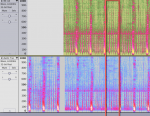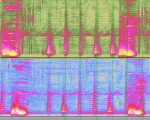Hey guys, finally got a small amount of time to work on the audio last night. I focused primarily on the long whale noise that ends each passage of small binary notes (the whale noise is referred to elsewhere in this thread as a "howl." After noting, as others have, that there are two types of these whale noises/howls which alternate, I was wondering if the passages they are attached to might be more than simple pairs. What if the different whale noises mean that each such set of paired passages should be treated as a single sequence? When these 14-16 note/purr sequences are translated into decimals they produce 4 digit integers.
Much more interestingly though, what if the different whale noises represent different messages or voices, such that each alternating sequence of 7-8 small notes belongs to a different message, or to two different speakers talking to or over one another? I haven't had the time to split the recordings apart this way, but I can't see how this can be solved without understanding the significance of the alternating howl sounds first.
Much more interestingly though, what if the different whale noises represent different messages or voices, such that each alternating sequence of 7-8 small notes belongs to a different message, or to two different speakers talking to or over one another? I haven't had the time to split the recordings apart this way, but I can't see how this can be solved without understanding the significance of the alternating howl sounds first.




